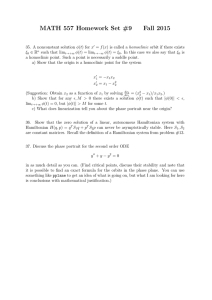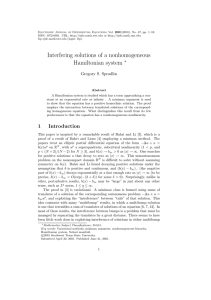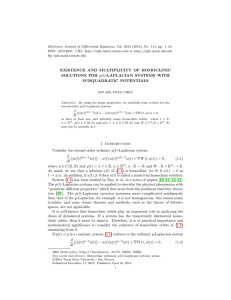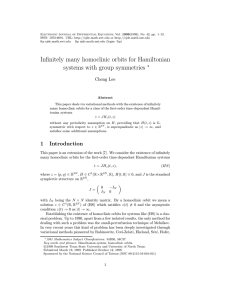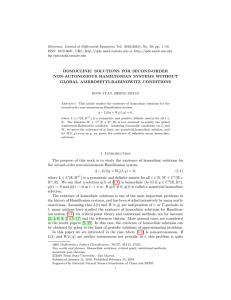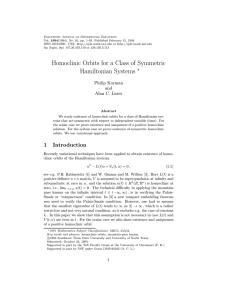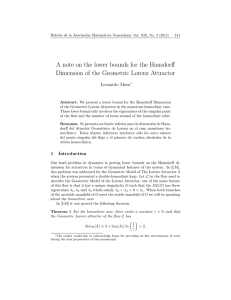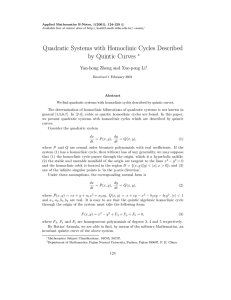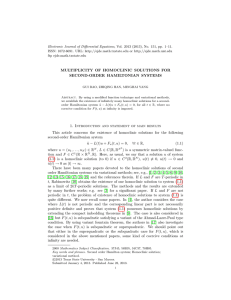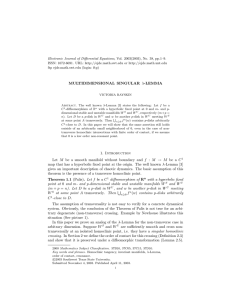Electronic Journal of Differential Equations, Vol. 2009(2009), No. 128, pp.... ISSN: 1072-6691. URL: or
advertisement
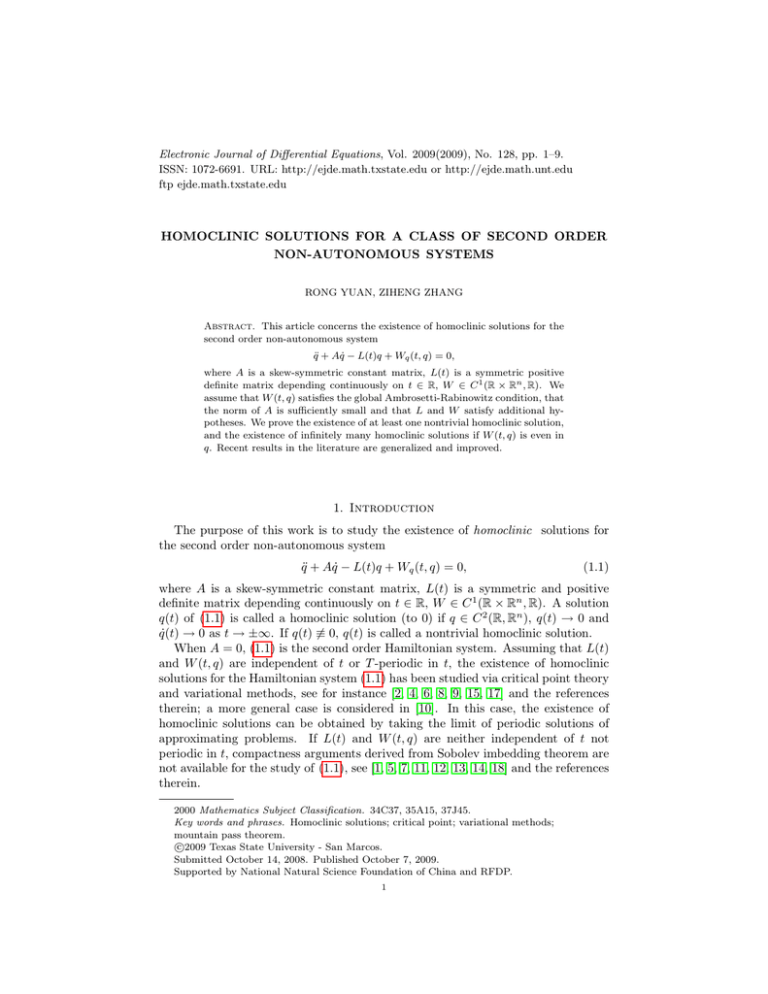
Electronic Journal of Differential Equations, Vol. 2009(2009), No. 128, pp. 1–9.
ISSN: 1072-6691. URL: http://ejde.math.txstate.edu or http://ejde.math.unt.edu
ftp ejde.math.txstate.edu
HOMOCLINIC SOLUTIONS FOR A CLASS OF SECOND ORDER
NON-AUTONOMOUS SYSTEMS
RONG YUAN, ZIHENG ZHANG
Abstract. This article concerns the existence of homoclinic solutions for the
second order non-autonomous system
q̈ + Aq̇ − L(t)q + Wq (t, q) = 0,
where A is a skew-symmetric constant matrix, L(t) is a symmetric positive
definite matrix depending continuously on t ∈ R, W ∈ C 1 (R × Rn , R). We
assume that W (t, q) satisfies the global Ambrosetti-Rabinowitz condition, that
the norm of A is sufficiently small and that L and W satisfy additional hypotheses. We prove the existence of at least one nontrivial homoclinic solution,
and the existence of infinitely many homoclinic solutions if W (t, q) is even in
q. Recent results in the literature are generalized and improved.
1. Introduction
The purpose of this work is to study the existence of homoclinic solutions for
the second order non-autonomous system
q̈ + Aq̇ − L(t)q + Wq (t, q) = 0,
(1.1)
where A is a skew-symmetric constant matrix, L(t) is a symmetric and positive
definite matrix depending continuously on t ∈ R, W ∈ C 1 (R × Rn , R). A solution
q(t) of (1.1) is called a homoclinic solution (to 0) if q ∈ C 2 (R, Rn ), q(t) → 0 and
q̇(t) → 0 as t → ±∞. If q(t) 6≡ 0, q(t) is called a nontrivial homoclinic solution.
When A = 0, (1.1) is the second order Hamiltonian system. Assuming that L(t)
and W (t, q) are independent of t or T -periodic in t, the existence of homoclinic
solutions for the Hamiltonian system (1.1) has been studied via critical point theory
and variational methods, see for instance [2, 4, 6, 8, 9, 15, 17] and the references
therein; a more general case is considered in [10]. In this case, the existence of
homoclinic solutions can be obtained by taking the limit of periodic solutions of
approximating problems. If L(t) and W (t, q) are neither independent of t not
periodic in t, compactness arguments derived from Sobolev imbedding theorem are
not available for the study of (1.1), see [1, 5, 7, 11, 12, 13, 14, 18] and the references
therein.
2000 Mathematics Subject Classification. 34C37, 35A15, 37J45.
Key words and phrases. Homoclinic solutions; critical point; variational methods;
mountain pass theorem.
c
2009
Texas State University - San Marcos.
Submitted October 14, 2008. Published October 7, 2009.
Supported by National Natural Science Foundation of China and RFDP.
1
2
R. YUAN, Z. ZHANG
EJDE-2009/128
When A 6= 0, as far as we know, the existence of homoclinic solutions of (1.1)
has not been studied. Our basic hypotheses on L and W are:
2
(H1) L ∈ C(R, Rn ), L(t) is a symmetric and positive definite matrix for all
t ∈ R, and there isa continuous function α : R → R such that α(t) > 0 for
all t ∈ R, L(t)q, q ≥ α(t)|q|2 , and α(t) → +∞ as |t| → +∞.
(H2) There exists a constant µ > 2 such that for every t ∈ R and q ∈ Rn \{0}
0 < µW (t, q) ≤ Wq (t, q), q .
(H3) Wq (t, q) = o(|q|) as |q| → 0 uniformly with respect to t ∈ R.
(H4) There exists W ∈ C(Rn , R) such that |Wq (t, q)| ≤ |W (q)| for every t ∈ R
and q ∈ Rn .
Remark 1.1. From (H1), we see that there is a constant β > 0 such that
L(t)q, q ≥ β|q|2 for all t ∈ R and q ∈ Rn .
(1.2)
(H2) is called the global Ambrosetti-Rabinowitz condition due to Ambrosetti and
Rabinowitz (e.g., [3]). Combining (H2) with (H3), we see that W (t, q) ≥ 0 for all
(t, q) ∈ R × Rn , W (t, 0) = 0, Wq (t, 0) = 0. Moreover, W (t, q) = o(|q|2 ) as |q| → 0
uniformly with respect to t, which implies that for any ε > 0 there is δ > 0 such
that
W (t, q) ≤ ε|q|2 for (t, q) ∈ R × Rn , |q| ≤ δ.
(1.3)
In addition, we need the following hypothesis on A.
√
(H5) kAk < β, where β is defined in (1.2).
Now we state our main result.
Theorem 1.2. Assume (H1)–(H5). Then (1.1) possesses at least one nontrivial
homoclinic solution. Moreover, if we assume that W (t, q) is even in q; i.e.,
(H6) W (t, −q) = W (t, q) for all t ∈ R and q ∈ Rn ,
then (1.1) has infinitely many distinct homoclinic solutions.
Remark 1.3. From Remark 1.1, we know that there exists β > 0 such that (1.2)
holds. However, since we do not have an explicit estimate on β, we simply assume
that kAk is sufficiently small. Furthermore, when A = 0, our main result is just
[13, Theorems 1 and 2].
To overcome the lack of compactness in standard Sobolev imbedding theorems,
we employ a compact imbedding theorem obtained in [13]. In Section 2 we state
and prove preliminary results. Section 3 is devoted to the proof of Theorem 1.2.
2. Preliminaries
Let
1
n
Z
E = q ∈ H (R, R ) :
|q̇(t)|2 + L(t)q(t), q(t) dt < +∞ .
R
This vector space is a Hilbert space when endowed with the inner product
Z
(x, y) =
ẋ(t), ẏ(t) + L(t)x(t), y(t) dt
R
and the corresponding norm kxk2 = (x, x). Note that
E ⊂ H 1 (R, Rn ) ⊂ Lp (R, Rn )
EJDE-2009/128
HOMOCLINIC SOLUTIONS
3
for all p ∈ [2, +∞] with the imbedding being continuous. In particular, for p = +∞,
there exists a constant C > 0 such that
kqk∞ ≤ Ckqk,
p
n
1
∀q ∈ E.
(2.1)
n
Here L (R, R ) (2 ≤ p < +∞) and H (R, R ) denote the Banach spaces of functions on R with values in Rn under the norms
Z
1/2
1/p
and kqkH 1 := kqk22 + kq̇k22
kqkp :=
|q(t)|p dt
R
respectively. L∞ (R, Rn ) is the Banach space of essentially bounded functions from
R into Rn equipped with the norm
kqk∞ := ess sup{|q(t)| : t ∈ R}.
Lemma 2.1 ([13, Lemma 1]). Assume L satisfies (H1). Then the embedding of E
in L2 (R, Rn ) is compact.
Lemma 2.2 ([13, Lemma 2]). Assume (H1), (H3), (H4). If qk * q0 (weakly) in
E, then Wq (t, qk ) → Wq (t, q0 ) in L2 (R, Rn ).
Lemma 2.3. Under Assumption (H2), for every t ∈ R, we have
q W (t, q) ≤ W t,
|q|µ , if 0 < |q| ≤ 1,
|q|
q W (t, q) ≥ W t,
|q|µ , if |q| ≥ 1.
|q|
(2.2)
(2.3)
Proof. It suffices to show that for every q 6= 0 and t ∈ R the function (0, ∞) 3 ζ →
W (t, ζ −1 q)ζ µ is non-increasing, which is an immediate consequence of (H2).
Remark 2.4. From Lemma 2.3, we see that there exists α0 (t) > 0 such that
W (t, q) ≥ α0 (t)|q|µ
for all (t, q) ∈ R × Rn , |q| ≥ 1.
Now we introduce more notation and some definitions. Let B be a real Banach
space, I ∈ C 1 (B, R), which means that I is a continuously Fréchet-differentiable
functional defined on B.
Definition 2.5 ([16]). I ∈ C 1 (B, R) is said to satisfy the (PS) condition if any
sequence {uj }j∈N ⊂ B, for which {I(uj )}j∈N is bounded and I 0 (uj ) → 0 as j → +∞,
possesses a convergent subsequence in B.
Moreover, let Br be the open ball in B with the radius r and centered at 0 and
∂Br denote its boundary. We obtain the existence and multiplicity of homoclinic
solutions of (1.1) by use of the following well-known Mountain Pass Theorems, see
[16].
Lemma 2.6 ([16, Theorem 2.2]). Let B be a real Banach space and I ∈ C 1 (B, R)
satisfying the (PS) condition. Suppose that I(0) = 0 and
(A1) there exist constants ρ, α > 0 such that I|∂Bρ ≥ α,
(A2) there exists e ∈ B \ B ρ such that I(e) ≤ 0.
Then I possesses a critical value c ≥ α given by
c = inf max I(g(s)),
g∈Γ s∈[0,1]
where
Γ = {g ∈ C([0, 1], B) : g(0) = 0, g(1) = e}.
4
R. YUAN, Z. ZHANG
EJDE-2009/128
Lemma 2.7 ([16, Theorem 9.12]). Let B be an infinite dimensional real Banach
space and I ∈ C 1 (B, R) be even satisfying the (PS) condition and I(0) = 0. If
B = V ⊕ X, where V is finite dimensional, and I satisfies
(A3) there exist constants ρ, α > 0 such that I|∂Bρ ∩X ≥ α and
(A4) for each finite dimensional subspace B̃ ⊂ B, there is an R = R(B̃) such that
I ≤ 0 on B̃\BR(B̃) ,
then I has an unbounded sequence of critical values.
3. Proof of Theorem 1.2
Now we establish the corresponding variational framework to obtain homoclinic
solutions of (1.1). Take B = E and define the functional I : E → R by
Z h
i
1
1
1
|q̇(t)|2 + Aq(t), q̇(t) + L(t)q(t), q(t) − W (t, q(t)) dt
I(q) =
2
2
R 2
Z
Z
(3.1)
1
1
= kqk2 +
Aq(t), q̇(t) dt − W (t, q(t))dt.
2
2 R
R
Lemma 3.1. Under the conditions of Theorem 1.2, we have
Z h
i
q̇(t), v̇(t) − Aq̇(t), v(t) + L(t)q(t), v(t) − Wq (t, q(t)), v(t) dt,
I 0 (q)v =
R
(3.2)
for all q, v ∈ E, which yields, using the skew-symmetry of A,
Z
Z 0
2
I (q)q = kqk −
Aq̇(t), q(t) dt −
Wq (t, q(t)), q(t) dt
ZR
ZR 2
= kqk +
Aq(t), q̇(t) dt −
Wq (t, q(t)), q(t) dt.
R
(3.3)
R
Moreover, I is a continuously Fréchet-differentiable functional defined on E; i.e.,
I ∈ C 1 (E, R) and any critical point of I on E is a classical solution of (1.1) with
q(±∞) = 0 = q̇(±∞).
Proof. We begin by showing that I : E → R. By (1.3), there exist constants M > 0
and R1 > 0 such that
W (t, q) ≤ M |q|2
0
for all (t, q) ∈ R × Rn , |q| ≤ R1 .
(3.4)
n
Letting q ∈ E, then q ∈ C (R, R ) (see, e.g., [17]), the space of continuous functions
q on R such that q(t) → 0 as |t| → +∞; i.e., E ⊂ C 0 (R, Rn ). Therefore there is a
constant R2 > 0 such that |t| ≥ R2 implies that |q(t)| ≤ R1 . Hence, by (3.4), we
have
Z
Z R2
Z
0≤
W (t, q(t))dt ≤
W (t, q(t))dt + M
|q(t)|2 dt < +∞.
(3.5)
−R2
R
|t|≥R2
Combining (3.1) and (3.5), we show that I : E → R.
Next we prove that I ∈ C 1 (E, R). Rewrite I as I = I1 − I2 , where
Z h
Z
i
1
I1 :=
|q̇(t)|2 + Aq(t), q̇(t) + L(t)q(t), q(t) dt, I2 :=
W (t, q(t))dt.
2 R
R
It is easy to check that I1 ∈ C 1 (E, R), and by using the skew-symmetry of A, we
have
Z h
i
0
I1 (q)v =
q̇(t), v̇(t) − Aq̇(t), v(t) + L(t)q(t), v(t) dt.
(3.6)
R
EJDE-2009/128
HOMOCLINIC SOLUTIONS
Therefore it is sufficient to consider I2 . In the process we will see that
Z
I20 (q)v =
Wq (t, q(t)), v(t) dt,
5
(3.7)
R
which is defined for all q, v ∈ E. For any given q ∈ E, let us define J(q) : E → R
as following
Z
J(q)v =
Wq (t, q(t)), v(t) dt, v ∈ E.
R
It is obvious that J(q) is linear. Now we show that J(q) is bounded. Indeed, for
any given q ∈ E, there exists a constant M1 > 0 such that kqk ≤ M1 and, by (2.1),
kqk∞ ≤ CM1 . According to (H3) and (H4), there is a constant b1 > 0 (dependent
on q) such that
|Wq (t, q(t))| ≤ b1 |q(t)| for all t ∈ R,
which by (1.2) and the Hölder inequality yields
Z
b1
(3.8)
Wq (t, q(t)), v(t) dt ≤ b1 kqk2 kvk2 ≤ kqk kvk.
|J(q)v| = β
R
Moreover, for q and v ∈ E, by the Mean Value Theorem, we have
Z
Z
Z
W (t, q(t) + v(t))dt − W (t, q(t))dt =
Wq (t, q(t) + h(t)v(t)), v(t) dt,
R
R
R
where h(t) ∈ (0, 1). Therefore, by Lemma 2.2 and the Hölder inequality, we have
Z
Z
Wq (t, q(t) + h(t)v(t)), v(t) dt −
Wq (t, q(t)), v(t) dt
R
R
Z
(3.9)
=
Wq (t, q(t) + h(t)v(t)) − Wq (t, q(t)), v(t) dt → 0
R
as v → 0. Combining (3.8) and (3.9), we see that (3.7) holds. It remains to prove
that I20 is continuous. Suppose that q → q0 in E and note that
Z
I20 (q)v − I20 (q0 )v =
Wq (t, q(t)) − Wq (t, q0 (t)), v(t) dt.
R
By Lemma 2.2 and the Hölder inequality, we obtain
I20 (q)v − I20 (q0 )v → 0
as q → q0 ,
I20
which implies the continuity of
and we show that I ∈ C 1 (E, R).
Lastly, we check that critical points of I are classical solutions of (1.1) satisfying
q(t) → 0 and q̇(t) → 0 as |t| → +∞. It is well known that E ⊂ C 0 (R, Rn ) (the
space of continuous functions q on R such that q(t) → 0 as |t| → +∞). On the
other hand, if q is a critical point of I, for any v ∈ E ⊂ C 0 (R, Rn ), by (3.2) we have
Z h
Z
i
q̇(t), v̇(t) − Aq̇(t), v(t) dt =
q̇(t) + Aq(t), v̇(t) dt
R
R
Z
=−
L(t)q(t) − Wq (t, q(t)), v(t) dt,
R
which implies that L(t)q − Wq (t, q) is the weak derivative of q̇ + Aq. Since L ∈
2
C(R, Rn ), W ∈ C 1 (R×Rn , R) and E ⊂ C 0 (R, Rn ), we see that q̇+Aq is continuous,
which yields that q̇ is continuous and q ∈ C 2 (R, Rn ); i.e., q is a classical solution of
(1.1). Moreover, it is easy to check that q satisfies q̇(t) → 0 as |t| → +∞ since q̇ is
continuous.
6
R. YUAN, Z. ZHANG
EJDE-2009/128
Lemma 3.2. Under Assumption (H1)-(H5), I satisfies the (PS) condition.
Proof. Assume that {uj }j∈N ⊂ E is a sequence such that {I(uj )}j∈N is bounded
and I 0 (uj ) → 0 as j → +∞. Then there exists a constant C1 > 0 such that
|I(uj )| ≤ C1 ,
kI 0 (uj )kE ∗ ≤ C1
(3.10)
for every j ∈ N.
We firstly prove that {uj }j∈N is bounded in E. By (3.1), (3.3), (H2) and the
Hölder inequality, we have
µ
− 1 kuj k2 = µI(uj ) − I 0 (uj )uj
2
Z
+
µW (t, uj (t)) − Wq (t, uj (t)), uj (t) dt
R
Z
(3.11)
µ
−1
Auj (t), u̇j (t) dt
−
2
R
kAk
µ
0
≤ µI(uj ) − I (uj )uj +
− 1 √ kuj k2 .
2
β
Combining this inequality with (3.10), we obtain
µ
kAk − 1 1 − √ kuj k2 ≤ µI(uj ) − I 0 (uj )uj ≤ µC1 + C1 kuj k.
(3.12)
2
β
√
Since µ > 2 and kAk < β, the inequality (3.12) shows that {uj }j∈N is bounded
in E. By Lemma 2.1, the sequence {uj }j∈N has a subsequence, again denoted by
{uj }j∈N , and there exists u ∈ E such that
uj * u,
uj → u,
weakly in E,
strongly in L2 (R, Rn ).
Hence
I 0 (uj ) − I 0 (u) (uj − u) → 0,
and by Lemma 2.2 and the Hölder inequality, we have
Z Wq (t, uj (t)) − Wq (t, u(t)), uj (t) − u(t) dt → 0,
R
and
Z
Au̇j (t) − Au̇(t), uj (t) − u(t) dt ≤ kAkku̇j − u̇kkuj − uk2 → 0
R
as j → +∞. On the other hand, an easy computation shows that
I 0 (uj ) − I 0 (u), uj − u
Z
= kuj − uk2 −
Au̇j (t) − Au̇(t), uj (t) − u(t) dt
R
Z −
Wq (t, uj (t)) − Wq (t, u(t)), uj (t) − u(t) dt.
R
Consequently, kuj − uk → 0 as j → +∞.
Now we can give the proof of Theorem 1.2, we divide the proof into several steps.
EJDE-2009/128
HOMOCLINIC SOLUTIONS
7
Proof of Theorem 1.2.
Step 1 It is clear that I(0) = 0 by Remark 1.1 and I ∈ C 1 (E, R) satisfies the (PS)
condition by Lemmas 3.1 and 3.2.
Step 2 We now show that there exist constants ρ > 0 and α > 0 such that I
satisfies the condition (A1) of Lemma 2.6. By (1.3), for all ε > 0, there exists δ > 0
such that W (t, q) ≤ ε|q|2 whenever |q| ≤ δ. Letting ρ = Cδ and kqk = ρ, we have
kqk∞ ≤ δ, where C > 0 is defined in (2.1). Hence W (t, q(t)) ≤ ε|q(t)|2 for all t ∈ R.
Integrating on R, we get
Z
ε
W (t, q(t))dt ≤ εkqk22 ≤ kqk2 .
β
R
In consequence, combining this with (3.1), we obtain that, for kqk = ρ,
Z
Z
1
1
I(q) = kqk2 +
Aq(t), q̇(t) dt − W (t, q(t))dt
2
2 R
R
1
1
kAk
ε
≥ kqk2 − √ kqk2 − kqk2
2
2 β
β
1 1 kAk
ε 2
− √ −
kqk .
=
2 2 β
β
Setting ε =
1
4β (1
−
kAk
√ ),
β
(3.13)
the inequality (3.13) implies
I|∂Bρ ≥
1
kAk δ 2
1− √
= α > 0.
4
β C2
Step 3 It remains to prove that there exists e ∈ E such that kek > ρ and I(e) ≤ 0,
where ρ is defined Step 2. By (3.1), we have, for every m ∈ R \ {0} and q ∈ E \ {0},
Z
Z
m2
m2
2
I(m q) =
kqk +
Aq(t), q̇(t) dt − W (t, m q(t))dt
2
2 R
R
Z
m2
kAk ≤
− W (t, m q(t))dt.
1+ √
2
β
R
Take some Q ∈ E such that kQk = 1. Then there exists a subset Ω of positive
measure of R such that Q(t) 6= 0 for t ∈ Ω. Take m > 0 such that m|Q(t)| ≥ 1 for
t ∈ Ω. Then, by (H5) and Remark 2.4, we obtain that
Z
m2
kAk I(m Q) ≤
1+ √
− mµ
α0 (t)|Q(t)|µ dt.
(3.14)
2
β
Ω
Since α0 (t) > 0 and µ > 2, (3.14) implies that I(mQ) < 0 for some m > 0 such
that m|Q(t)| ≥ 1 for t ∈ Ω and kmQk > ρ, where ρ is defined in Step 2. By Lemma
2.6, I possesses a critical value c ≥ α > 0 given by
c = inf max I(g(s)),
g∈Γ s∈[0,1]
where
Γ = {g ∈ C([0, 1], E) : g(0) = 0, g(1) = e}.
Hence there is q ∈ E such that I(q) = c, I 0 (q) = 0.
Step 4 Now suppose that W (t, q) is even in q; i.e., (H6) holds, which implies that
I is even. Furthermore, we already know that I(0) = 0 and I ∈ C 1 (E, R) satisfies
the (PS) condition in Step 1.
8
R. YUAN, Z. ZHANG
EJDE-2009/128
To apply Lemma 2.7, it suffices to prove that I satisfies the conditions (A3) and
(A4) of Lemma 2.7. Here we take V = {0} and X = E. (A3) is identically the same
as in Step 2, so it is already proved. Now we prove that (A4) holds. Let Ẽ ⊂ E be
a finite dimensional subspace. From Step 3 we know that, for any Q ∈ Ẽ ⊂ E such
that kQk = 1, there is mQ > 0 such that
I(mQ) < 0
for every |m| ≥ mQ > 0.
Since Ẽ ⊂ E is a finite dimensional subspace, we can choose an R = R(Ẽ) > 0 such
that
I(q) < 0,
∀q ∈ Ẽ\BR .
Hence, by Lemma 2.7, I possesses an unbounded sequence of critical values {cj }j∈N
with cj → +∞. Let qj be the critical point of I corresponding to cj , then (1.1) has
infinitely many distinct homoclinic solutions.
References
[1] C. O. Alves, P. C . Carrião and O. H. Miyagaki; Existence of homoclinic orbits for asymptotically periodic systems involving Duffing-like equation, Appl. Math. Lett., 16 (2003), no.
5, 639-642.
[2] A. Ambrosetti and V. Coti Zelati; Multiple homoclinic orbits for a class of conservative
systems, Rend. Sem. Mat. Univ. Padova., 89 (1993), 177-194.
[3] A. Ambrosetti and P. H. Rabinowitz; Dual variational methods in critical point theory and
applications, J. Funct. Anal., 14 (1973), no. 4, 349-381.
[4] P. Caldiroli and P. Montecchiari; Homoclinic orbits for second order Hamiltonian systems
with potential changing sign, Comm. Appl. Nonlinear Anal., 1 (1994), no. 2, 97-129.
[5] P. C. Carrião and O. H. Miyagaki; Existence of homoclinic solutions for a class of timedependent Hamiltonian systems, J. Math. Anal. Appl., 230 (1999), no. 1, 157-172.
[6] V. Coti Zelati and P. H. Rabinowitz; Homoclinic orbits for second order Hamiltonian systems
possessing superquadratic potentials, J. Amer. Math. Soc., 4 (1991), no. 4, 693-727.
[7] Y. Ding; Existence and multiplicity results for homoclinic solutions to a class of Hamiltonian
systems, Nonlinear Anal., 25 (1995), no. 11, 1095-1113.
[8] Y. Ding and M. Girardi; Periodic and homoclinic solutions to a class of Hamiltonian systems
with the potentials changing sign, Dynam. Systems Appl., 2 (1993), no. 1, 131-145.
[9] A. Flavia; Periodic and homoclinic solutions to a class of Hamiltonian systems with indefinite
potential in sign, Boll. Un. Mat. Ital., B (7) 10 (1996), no. 2, 303-324.
[10] M. Izydorek and J. Janczewska; Homoclinic solutions for a class of the second order Hamiltonian systems, J. Differential Equations, 219 (2005), no. 2, 375-389.
[11] P. Korman and A. C. Lazer; Homoclinic orbits for a class of symmetric Hamiltonian systems,
Electron. J. Differential Equations, (1994), no. 01, 1-10.
[12] Y. Lv and C. Tang; Existence of even homoclinic orbits for a class of Hamiltonian systems,
Nonlinear Anal., 67 (2007), no. 7, 2189-2198.
[13] W. Omana and M. Willem; Homoclinic orbits for a class of Hamiltonian systems, Differential
Integral Equations, 5 (1992), no. 5, 1115-1120.
[14] Z. Ou and C. Tang; Existence of homoclinic solution for the second order Hamiltonian
systems; J. Math. Anal. Appl., 291 (2004), no. 1, 203-213.
[15] E. Paturel; Multiple homoclinic orbits for a class of Hamiltonian systems, Calc. Val. Partial
Differential Equations, 12 (2001), no. 2, 117-143.
[16] P. H. Rabinowitz; Minimax Methods in Critical Point Theory with Applications to Differential Equations, in: CBMS Reg. Conf. Ser. in. Math., vol. 65, American Mathematical Society,
Providence, RI, 1986.
[17] P. H. Rabinowitz; Homoclinic orbits for a class of Hamiltonian systems, Proc. Roy. Soc.
Edinburgh Sect. A., 114 (1990), no. 1-2, 33-38.
[18] P. H. Rabinowitz and K. Tanaka; Some results on connecting orbits for a class of Hamiltonian
systems, Math. Z., 206 (1991), no. 3, 473-499.
EJDE-2009/128
HOMOCLINIC SOLUTIONS
9
Rong Yuan
School of Mathematical Sciences, Beijing Normal University, Laboratory of Mathematics and Complex Systems, Ministry of Education, Beijing 100875, China
E-mail address: ryuan@bnu.edu.cn
Ziheng Zhang
School of Mathematical Sciences, Beijing Normal University, Laboratory of Mathematics and Complex Systems, Ministry of Education, Beijing 100875, China
E-mail address: zhzh@mail.bnu.edu.cn

